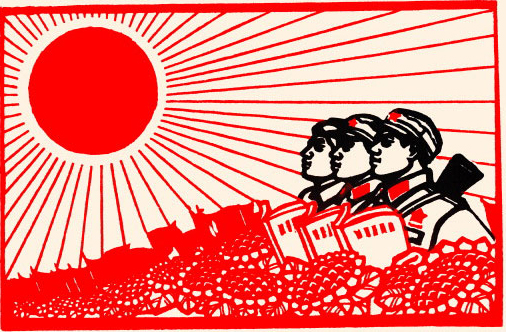The graphics of China
 First published by Design Week, November 1990
First published by Design Week, November 1990Chinese graphic design in the twentieth century, by Scott Minick and Jiao Ping, Thames & Hudson, 1990
This book is a revelation. Maryland’s Scott Minick and his wife, Shanghai’s Jiao Ping, have salvaged some momentous images before, they hint, the Middle Kingdom runs into another round of earthquakes, wars and revolutions. Their prose is clear; their colour pictures, beguiling.
From its invention of paper (first century AD) to its development of woodblock printing and movable type (AD 600-1048), China has long had a great tradition in the graphic arts. Its domination by Western powers, however, has brought mixed results.
Some merely mimicked Occidental styles. Others, following the vernacular writing and design of the inter‑war period’s Lu Xun, achieved a brilliant synthesis of Eastern and Western ideas. Others still engaged in a Maoist celebration of the backward peasant life – a fusing of regional folk art and folk heroes, Han nationalism and the socialist realism of Stalin.
Once Western firms set up design studios in Shanghai, as British American Tobacco did in 1902, they strengthened each of these three trends. When the 1919 Treaty of Versailles upheld Japanese power in China, its May Fourth student movement of the same year pushed designers away from old narrative and harmonious forms, and toward free abstraction and emotion. The effects, to my eyes, were best personified by Qian Jun‑tao, a Shanghai musician who befriended Lu Xun.
Qian’s book‑covers rose above even the delightful Art Deco ads which led the ‘Shanghai Style’: ads about cigarettes, cosmetics, ready‑to‑wear dresses, pharmaceuticals and social diseases. And, while other designers amiably followed Rodchenko in photography and montage, Qian also proved a Chinese Lissitsky. He put Chinese calligraphy in a kind of sans serif format, and used its up‑and-down, left‑to‑right potentialities to the full.
In 1942, in his mountain retreat of Yan’an, Mao made a key address to a forum of artists and writers gathered there. Its spirit was captured by his later dictum about art: that ‘the more artistic it is, the more harm it can do the people’. With America’s intervention in Korea in 1950, the revolution by default that had occurred in 1949 found itself stiffening in resolve. China, which had long been pulled apart by rival imperialisms, was now unified: its economy grew apace. Thus would its designers slavishly follow Mao’s line until the Great Helmsman died in 1976.
Yet their work wasn’t all bad. While the 1950s meant drab photos of factories, farms and construction, the swift failure of Mao’s Great Leap Forward in agriculture of 1958 let in some wonderful illustration – until the Cultural Revolution of 1966 engulfed the world for a decade in hyper‑realist posters idolising Mao, as well as ads for the risible operas favoured by his wife. Since Deng Xiao‑ping’s open door policy of 1978, however, Chinese graphics has advanced rapidly. Of particular note are the low‑tech prints of Qin Long, the use of airbrush à la Alan Aldridge, and a tasteful revival of folk traditions.
As with most of today’s design history, this book neglects the impact of key upheavals on creative practice. We learn nothing of the Boxer Rebellion of 1900, of Sun Yat Sen, the crushing of the revolution in Shanghai in 1927, or the Sino‑Soviet split of 1958. But this is to cavil. The authors are to be congratulated. More please!
Fmr President of Kenya on Trump cutting off foreign aid:
“Why are you crying? It’s not your government, he has no reason to give you anything. This is a wakeup call to say what are we going to do to help ourselves?”
America first is good for the world.
Our entire Green Socialist establishment should be banged up under the ‘Online Safety’ laws, for spreading demonstrable lies (the ‘climate crisis’), causing non-trivial harm to the industrial working class, ordinary drivers, farmers, taxpayers etc, etc.
#Chagos? #Mauritius PM Navin Ramgoolam "is reported to want Starmer to pay £800m a year, plus ‘billions of pounds in #reparations’." (14 January) https://www.spiked-online.com/2025/01/14/the-chagos-islands-deal-is-an-embarrassment/
Now the Torygraph wakes up https://telegraph.co.uk/gift/1ff8abbb462cd609
Read @spikedonline - first with the news!
Articles grouped by Tag
Bookmarks
Innovators I like

Robert Furchgott – discovered that nitric oxide transmits signals within the human body

Barry Marshall – showed that the bacterium Helicobacter pylori is the cause of most peptic ulcers, reversing decades of medical doctrine holding that ulcers were caused by stress, spicy foods, and too much acid

N Joseph Woodland – co-inventor of the barcode

Jocelyn Bell Burnell – she discovered the first radio pulsars

John Tyndall – the man who worked out why the sky was blue

Rosalind Franklin co-discovered the structure of DNA, with Crick and Watson

Rosalyn Sussman Yallow – development of radioimmunoassay (RIA), a method of quantifying minute amounts of biological substances in the body

Jonas Salk – discovery and development of the first successful polio vaccine

John Waterlow – discovered that lack of body potassium causes altitude sickness. First experiment: on himself

Werner Forssmann – the first man to insert a catheter into a human heart: his own

Bruce Bayer – scientist with Kodak whose invention of a colour filter array enabled digital imaging sensors to capture colour

Yuri Gagarin – first man in space. My piece of fandom: http://www.spiked-online.com/newsite/article/10421

Sir Godfrey Hounsfield – inventor, with Robert Ledley, of the CAT scanner

Martin Cooper – inventor of the mobile phone

George Devol – 'father of robotics’ who helped to revolutionise carmaking

Thomas Tuohy – Windscale manager who doused the flames of the 1957 fire

Eugene Polley – TV remote controls



0 comments